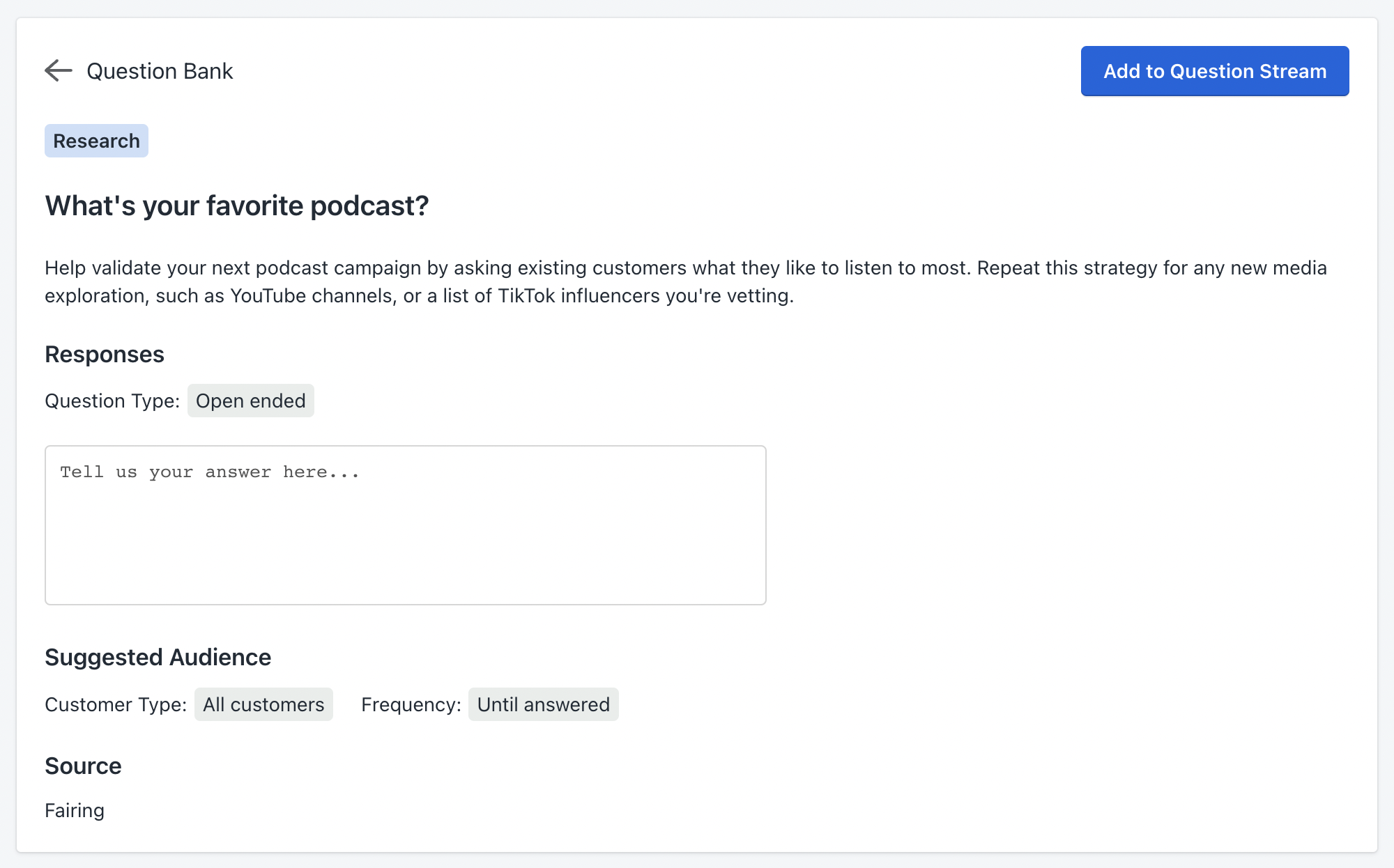Survey Question Types Explained With Examples For Ecommerce Brands
Surveys are a great way for Ecommerce brands to collect — and take
action on — customer insights that can change the trajectory of lifetime
value in your favor. And yet, not all survey questions are created
equal. The type of question you ask will have notable impacts on the
data you ingest, and therefore, what you can action on.
For that reason, Fairing has listed out some of the most versatile and
applicable survey question types for Ecommerce.
Survey question types
Fairing’s app takes less than five
minutes to set up and our customers have access to our Question
Bank .
That let’s them easily add our pre-built questions saving time while
following survey methodology best practices.
Here are some of the common survey question types that Fairing customers
use to collect customer insights. Each question type is unique in the
information if collects and a similar question asked in two different
formats could yield very different results based on what you’re looking
for.
Open-ended questions
Open-ended questions allow you to collect qualitative data and discover
new insights through free-form answers.
They are great for gathering insights about how customers feel or think
about a product or service, and can provide information that you may not
have thought to ask about. The downside is that analyzing qualitative
data can be time-consuming and challenging which is why these are often
paired with close-ended questions.
Let’s say you want to discover the content your customers consume the
most and turn that research into ad campaigns, so you ask them, “
What's your favorite
podcast? ”

Closed-ended questions
Closed-ended questions provide multiple-choice answers, and are great
for collecting quantitative data that can be easily analyzed. They
provide a clear and concise way to gather specific information about
your customers. The downside is that they don't allow customers to
provide detailed answers.
One good example is asking the question, “Who is this purchase for?”
which helps your customers self-segment as buyers or users.

If you’re in an industry where gift purchases are common then knowing
this would make a big difference in how you communicate with your
customers. If someone said they purchased it as a gift then you know
they’re a buyer, and they know someone else who advocates for your
product. And with the correct messaging that might lead to a future
user.
Now that you know who your buyers and users are you can split them for
analysis to clean up your performance metrics. Your buyers might have a
higher churn rate, but by segmenting the two, you’ll have a better idea
of how your customer relationships are performing.
Demographic questions
Demographic questions ask for personal information about the customer,
such as age, gender, or income level. They can provide insights into who
your customers are and what types of products they might be interested
in. However, you need to be sensitive in the way you ask these
questions, as some customers may be uncomfortable sharing personal
information.
By asking customers, "What is your age?" you can segment them into
different age demo breaks for media and creative purposes.
Benchmark questions
Benchmark questions can come in multiple formats, but allow you to
compare customer feedback to industry standards or internal goals. They
can provide a way to see how your product or service stacks up against
competitors. They are useful for measuring brand awareness, customer
loyalty, and customer satisfaction.
For instance, you could ask your customers if they are switching from
another brand to find competitors and use follow up questions to see how
your product compares.

Brands like Quip have used similar
questions in their post-purchase surveys for years. They’ve pulled out
tactical responses like optimizing ad creative and competitive bidding
from responses, and used the information for more strategical purposes
like pitching to investors.
Dropdown questions
Dropdown questions provide a list of possible answers, and are great for
situations where you want the customer to choose a specific option.
They can be useful for gathering information about product preferences
or usage. However, they can be limiting if the customer's answer isn't
included in the options provided.
For example, you ask your customers “ When is your
birthday? ”
knowing when your customers’ birthdays are can be a personalization
powerhouse. But for that information to be useful, you need it in the
same format every time so you use a dropdown.

The birthday use case is already something that many marketers have
ingrained in their brain, but what may not be readily obvious is the
benefit of combining this with other direct-from-consumer data. Maybe a
customer has told you through another question about what region they
live in. If so then you already have a good idea of their environment
and what it’s like on that day. A segment of U.S. customers with
birthdays in Oct & Nov sounds like a great target for gifting your
pumpkin spice flavored beverage, yes?
The survey question type plays a crucial role in gathering responses.
Whether you're using an open-ended question to gather qualitative
responses or a close-ended one for easier analysis the different
question types can lead to very different insights.
If you're looking for an easy and efficient way to get started with
surveys, then check out our post-purchase survey
app
. With our integrated Question Bank you can have your survey live and
start collecting customer insights in less than five minutes.